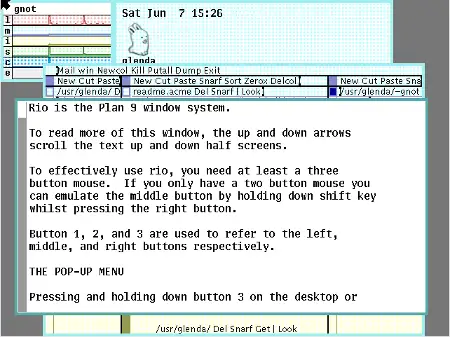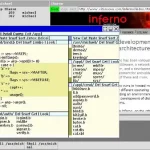Last Updated on: 10th May 2023, 05:06 pm
Web site: plan9.bell-labs.com/plan9/
Origin: USA
Category: Specialist
Desktop environment: Rio
Architecture: x86, x86_64, MIPS, DEC Alpha, SPARC, PowerPC, ARM
Based on: Independent
Wikipedia: Plan 9
Media: Live CD/USB
The last version | Released: 4 | 2002
![]() Zobacz po polsku: Plan 9
Zobacz po polsku: Plan 9
Plan 9 – a distributed operating system, originally developed by the Computing Sciences Research Center at Bell Labs between the mid-1980s and 2002. Its original designers and authors were Ken Thompson, Rob Pike, Dave Presotto, and Phil Winterbottom.
Plan 9 demonstrates a new and often cleaner way to solve most systems problems. The system as a whole is likely to feel tantalizingly familiar to Unix users but at the same time quite foreign.
Plan 9 is an operating system kernel but also a collection of accompanying software. The bulk of the software is predominantly new, written for Plan 9 rather than ported from Unix or other systems. The window system, compilers, file server, and network services are all freshly written for Plan 9. Although classic Unix programs like dc, ed, and troff have been brought along, they are often in an updated form.
Starting with the release of Fourth edition on April 2002, the full source code of Plan 9 from Bell Labs was freely available under Lucent Public License 1.02.
There is an open source fork of Plan 9 called 9front (or Plan9front) being still under active development.





This should be it’s own category rather than under “Others”. Just the look at all the processors it runs on! I remember in ’94, learning Novell networking on what I found out to be Dr.DOS with digital copyright notices changed.At the time I thought it was kind of a sneaky way for them to seemlessly integrate into Microsoft dominated tech shops. Win95 was late, and anyone withMeanwhile “Plan 9” was legendary even back then, and I would wistfully hope I’d find a floppy disk for x86 (or even a for an 8088 CPU). For historical importance this blows all the other operating systems away.
I don’t remember hearing about Plan 9 in those days (when Win95 was supposed to come out), I think I first heard of it a few years ago. Was it that hard to find a copy of Plan 9? Did you have to find a L33T BBS or something? That was way before I’d ventured into non-MS or non-Apple territory, aside from Novell. Speaking of which, I think it ran on DOS so they didn’t have to rewrite the base OS, and could write their networking OS on top. As I recall, it was semi it’s own OS, DOS somehow launched it into its own OS. But I do miss it! I was a NetWare admin for several years, and as long as the hardware was good, it just ran. I don’t recall a single crash unrelated to hardware failure. And it was predictable – once you knew how to configure the network adapters and manage it, it always did what you wanted (more or less). I swear, computers have become far less reliable in general (Internet, too). Too complex and bloated. In those days, on the Novell and Unix systems I managed, the only thing that ever went wrong was a failing hard disk. And the DOS clients that ran on the NetWare networks were equally as stable, unless someone was running crappy applications. Most people also didn’t know how to manage those things back then, so we were almost like gods to everybody else. Now, everybody is a “techie”.
Plan 9 still has an active community though most of the development effort is behind various forks: 9front, Harvey, Akaros, NIX, 9atom, and JehanneOS. There is also 9legacy, a set of patches for the Bell Labs version which brings some updates though it is abandoned. 9front is probably the closest to the Bell Labs plan 9 code base and design. The others take various different approaches to design philosophy and focus, some more radical than others.
You couldn’t get Plan 9 because was closed source until the year 2000, sadly. IIRC, the price was much higher than home/small-biz OSs.
I think that this OS should be given the TUI label.